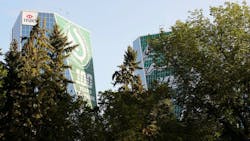The sky has a certain clarity, a very specific shade of blue when the temperature is -30°C. It was on such a day I was flying into Regina, Saskatchewan. For those of you who have no idea where that is, let me first say it is a city located on the Great Plains. It’s north of North Dakota. So as you are approaching the city, the landscape is about as bare and flat as a billiard table. From the air, the city is clearly demarcated from the prairie by trees – lots of trees.
In doing research for the Effects of Tree Mortality on Power Line Security I referenced some 2001 U.S. Forest Service work that stated urban tree cover was 27%. Well that statistic didn’t come close to describing the impression I was left with flying into Regina. My education would continue the next day as I got to see this urban forest from the ground.
I was touring SaskPower facilities, seeing the work they had done and the challenges they face. They have a substantial amount of power lines that run across backyards, some along back alleys but much of it without any vehicle access. When you look along these lines from one block to the next, it’s often difficult to see any poles because of the trees. I can’t really fault the designers and engineers for the situation. After all, when the lines were built I’m sure you could clearly see across these backyards as they would have looked like the aforementioned billiard table. Who would have thought people would fill this space with trees?
It’s probably a safe assumption that from the 1980s onward, most power lines in urban developments were put underground. That means these backyard trees are at least 30 years old and probably average in the 50-60 year range.
The conditions on the Great Plains favor short-lived tree species, and long-lived species face numerous environmental stresses. Consequently, a considerable portion of the tree population I saw in proximity to power lines was decadent.
Last month we concluded that maintaining trees at one-half or one-third of their natural mature height can’t help but produce disfigured trees. The situation of decadent trees in Regina highlights another issue. It applies to trees that require little or no pruning but could, on failure, take out the power line. Who is maintaining these trees? My personal opinion is that in most cases, no one is. Perhaps commercial arborists have data to alter my perception. What percent of privately owned trees are under active management?
We are talking about far more trees than fall clearly and directly under utility management. If we consider 70-foot trees and typical distribution construction, beyond the first eight feet outside the right of way, which would typically be maintained by the utility due to the hazards associated with working in proximity to energized lines, there are more than 40 feet or five acres per mile that can potentially hold trees. Depending on the ecoregion you are located in, we are talking about a considerable number to an enormous number of trees that should be under private care and maintenance.
How did we ever get into the predicament where the utilities are held accountable for storm-related, tree-caused outages while the owners of trees are not held responsible and accountable? Where are the community protests over the irresponsible landowner who fails to maintain the health and structural integrity of his trees or worse, has refused utility attempts to mitigate the risk?
About the Author
Sig Guggenmoos
P. Ag. CPC President, Ecological Solutions Inc., Sherwood Park, Alberta, Canada
Education: Bachelor of Science in Agriculture B.Sc.(Agr.)
Accreditations: Professional Agrologist (P.Ag.); Certified Professional Consultant (CPC)
Organizations: Alberta Institute of Agrologists, International Society of Arboriculture, Utility Arborist Association, Industrial Vegetation Management Association of Alberta.
Mr. Guggenmoos was a chief architect of the TransAlta Utilities Distribution Line Clearance program, which reduced tree related outages 80%; saved 48 million dollars over two maintenance cycles; had a 98% customer satisfaction rating; and, showed a 21% increase in contractor crew productivity. He was responsible for the herbicide program, associated research and communication. In addition, he brought a financial focus to the program, developing processes for financial comparisons of alternatives to repetitive tree pruning and was intimately involved in the design and assessment of contracting methods.
As president of Ecological Solutions Inc. (Ecosync) Mr. Guggenmoos provides consulting services in vegetation management and biotic greenhouse gas mitigation strategies including biomass-derived energy.
Publications and Presentations:
Author of numerous abstracts and publications; numerous presentations to public, industry and professional associations including international conferences. List of publications available upon request.
